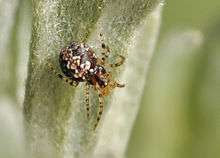Theridion logan
Theridion logan is a species of spider in the family Theridiidae. Its Latin name refers to Logan Canyon, Utah, where the species was first discovered. The spider was discovered by two Utah State University doctoral students, Stephanie Cobbold and Lori Spears, while performing research on spider communities in Logan Canyon.[1]
| Theridion logan | |
|---|---|
 | |
| Scientific classification | |
| Kingdom: | |
| Phylum: | |
| Class: | |
| Order: | |
| Suborder: | |
| Family: | |
| Genus: | |
| Species: | T. logan |
| Binomial name | |
| Theridion logan Levi and Patrick, 2013 | |
Appearance
T. logan is approximately 2 millimetres (0.079 in) long, with the female being slightly wider and longer than the male.[2] The spider has a black and white round body, with chevron stripes on its abdomen and spots on its top.[1][3] Its appearance most closely matches Theridion rabuni.[2]
Distribution
T. logan has been discovered in three locations, all near the city of Logan, Utah: Logan Canyon, Green Canyon, and Blacksmith Fork Canyon.[1] Although these spots are popular recreational areas, the spider does not seem to be affected by the presence of humans. Despite the limited distribution, T. logan does not appear to be in danger of extinction.[1]
Ecology
The species is found in sagebrush and other shrubs in its distribution area.[3] Like most Theridiidae, it spins irregular three-dimensional webs. Prey most likely is limited to small insects. The venom of T. logan is considered harmless to humans.[1]
References
- "USU spider-women stumble upon new species". Deseret News. 20 January 2014. Retrieved 21 January 2014.
- Levi, H. W.; Patrick, L. B. (November 2013). "Two new North American Theridion species (Araneae: Theridiidae)". Journal of Arachnology. 41 (3): 409–411. doi:10.1636/k12-47.1.
- "New arachnid on the block: USU researchers find previously unknown species unique to Cache canyons". 23 November 2013. Retrieved 21 January 2014.